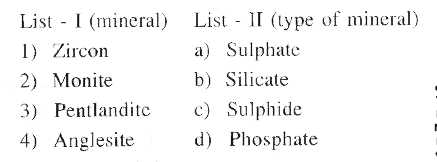(A): Metals like Sn and Pb can be refined by liquation
(R) : Sn and Pb are readily fusible and can be separated from less fusible impurities on heating Solution in Telugu
Both A & R are true, R is the correct explanation of A
Both A & R are true, R is not correct explanation of A
A is true, R is false
A is false, R is true
The correct Answer is:A
Step by step video, text & image solution for (A): Metals like Sn and Pb can be refined by liquation (R) : Sn and Pb are readily fusible and can be separated from less fusible impurities on heating by Chemistry experts to help you in doubts & scoring excellent marks in Class 12 exams.
Topper's Solved these Questions
- BOOK - AAKASH SERIESCHAPTER - PRINCIPLES OF METALLURGYEXERCISE - OBJECTIVE EXERCISE-245videos
PRINCIPLES OF METALLURGY
- BOOK - AAKASH SERIESCHAPTER - PRINCIPLES OF METALLURGYEXERCISE - PRACTICE EXERCISE84videos
PRINCIPLES OF METALLURGY
- BOOK - AAKASH SERIESCHAPTER - PRINCIPLES OF METALLURGYEXERCISE - SUBJECTIVE EXERCISE-4 ( VERY SHORT ANSWER QUESTIONS )18videos
PRINCIPLES OF METALLURGY
- BOOK - AAKASH SERIESCHAPTER - PRACTICAL CHEMISTRYEXERCISE - PRACTICE SHEET-5 (Integer answer Type questions)6videos
PRACTICAL CHEMISTRY
- BOOK - AAKASH SERIESCHAPTER - PROTEINS AND NUCLEIC ACIDS EXERCISE - PRACTICE SHEET - 430videos
PROTEINS AND NUCLEIC ACIDS
Similar Questions
 Correct Match is 02:26View Solution
Correct Match is 02:26View SolutionNickel steel is used in making
View SolutionWrite any two minerals of Cu.
View Solution1.575 gm of organic acid was dissolved in 250ml of water 20ml of this solution required 16 ml of N/8 alkali solution for completely neutralization. (M. wt of acid is 126) the basicity of acid is
View SolutionAnti bodies are ………..
03:24View SolutionStatement-1: Pb, Sn and Bi are purified by liquation.
Statement-2: Impurities have lower meltin point than metal.02:30View SolutionAssertion: Pb, Sn and Bi are purified by liquation,
Reason: Pb, Sn and Bi have lower m.pt then the impurities present .05:06View SolutionUsing Nernst equation for the cell reaction, Pb+Sn^(2+) rarr Pb^(2+)+Sn Calculate the ratio ([Pb^(2+)])/([Sn^(2+)]) for which E_(cell)=0 (Given : E_(Pb//Pb^(2+))^(@)=0.13 volt and E_(Sn^(2+)//Sn)^(@)=-0.14 volt)
View SolutionWhat ratio of Pb2+ to Sn2+ concentration is needed to reverse the following cell reaction ?
Sn(s)+Pb2+(aq.)→Sn2+(aq.)+Pb(s)
E∘Sn2+/Sn=−0.136 volt and E∘Pb2+/Pb=−0.126 volt04:42View SolutionGiven: E_(Sn^(2+)//Sn) ^0 = -0.14V , E_(Pb^(2+)//Pb) ^0 = -0.13V . Determine [(Sn^(2+))//(Pb^(2+))] at equilibrium. For cell reaction Sn |Sn^(2+) || Pb^(2+) | Pb , Take (2.303RT)//F = 0.06V
03:47View Solutionक्षारकीय अशुद्धियों को पृथक् करने के लिए……… का प्रयोग किया जाता है। यह अशुद्धियों के साथ संयुक्त होकर एक गलनीय पदार्थ बनाता है, जिसे
03:47View SolutionZn , Sn और Pb किस धातु से कम अभिक्रियाशील है -
03:07View SolutionPb and Sn are extracted from their chieforeby
View SolutionFor an electrochemical cell
Sn(s)∣∣Sn2+(aq,1M)∣∣∣∣Pb2+(aq,1M)∣∣Pb(s) the ratio [Sn2+][Pb2+] when this cell attains equilibrium is _________________.
(Given E∘Sn2+∣Sn=−0.14V, E∘Pb2+∣Pb=−0.13V,2.303RTF=0.06)08:57View SolutionFor an electrochemical cell Sn(s)Sn^(2+) (aq,1M)||pb^(2+) (Aq,1M)|Pb(s) the ratio ([Sn^(2+)])/([Pb^(2+)] when this cell attians equilibrium is_______ (Given : E_(sn^(2+)|Sn)^(@) = -0.14V, E_(pb^(2+|Pb^(@))= -0.13V, (2.303RT)/(F = 0.06))
07:22View SolutionFor an electrochemical cell
Sn(s)/Sn2+(aq,1M)∣∣∣Pb2+(aq,1M)∣∣Pb(s)
the ratio ([Sn2+])/([Pb2+] when this cell attians equilibrium is_______ (Given : E∘Sn2+∣Sn = -0.14V, E∘Pb2+∣Pb= -0.13V, 2.303RTF=0.06))03:23View Solution

